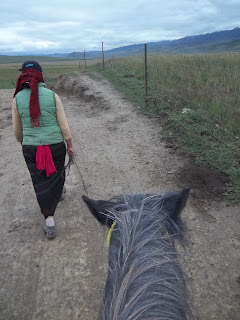But to continue with the trip to Gansu province China:
I knew I would like the desert much more than I liked Tibet as soon as we stepped off the train in Dunhuang. We arrived early in the morning from our overnight sleeper train and the sunrise was amazing! It was so beautiful.
The first thing we did in the desert was visit the sand dunes, of course! We went to a state park which is pretty much just miles and miles of sand. Huge mountains of sand that look just as impressive and striking as you would imagine them to be. But being China, the state park couldn't be content with just the sand. They also advertised a beautiful oasis in the middle of these dunes. This was by far the most man-made oasis I've ever seen. Maybe at one point there was a natural spring and oasis in the area, but today it is definitely a concrete pool and "historic" pagoda built in the ancient 1990s. That's the thing about China, though: for a country with such a long and amazing history almost none of it still exists. Most of the incredible ancient structures have been torn down either during the Cultural Revolution or because of the huge property boom going on throughout China right now.
Aside from the unimpressive oasis, the dunes park was pretty cool. Mainly because of the extreme sand sports. We took ATVs up the dunes! At the top of the dunes were sleds on which you could glide over the sand back down the dune. On the way there they let you pseudo-drive (there was a guy there with you to make sure you didn't crash), but on the way back from the dune the professional driver took us up and down and all over the dunes. Its exactly as cool as it looks on TV. And it was so much fun!
After the dunes park we went to the Magao caves. This is a really interesting national site. One of the first sights of Buddhism in China, the Magao caves are also called the Cave of One Thousand Buddhas. hundreds of caves are carved into the side of a cliff with elaborate paintings and sculptures decorating the inside depicting the Buddha. These Buddhas are hundreds of years old and are still pretty well preserved. There are two GIANT Buddhas carved inside some caves out of the rock. These Buddhas are about five stories tall and are very ornate. It's almost scary standing there in the dark cave at the feet of this massive seated Buddha staring down at you.
 | |
| Behind this facade is the Giant Buddha. Who knew China had some many of those things? |
With no time for resting, after we saw one thousand Buddhas we hopped on camels to trek across the desert to our camping spot. The camels were so much fun and so cute! We rode them caravan-style, tied together led by a little old Chinese man. We rode the camels for two hours into the desert. The certain spot in the desert where we camped was all set up and waiting for us to arrive in our camel caravans. At night we built a bonfire, roasted meat and veggie skewers, and ran around in the desert. It was pretty chill, just how you would expect an evening in the desert to be.
 |
| For only 6000RMB you can take home your own pet camel! |
The next day was pretty uneventful. Except for the evening. On our last night of the trip we hung out in Dunhuang. Dunhuang is a modern town with all of five streets: North St, South St, East St, West St, and Fifth Avenue. No joke. Even though its so small, Dunhuang was a much more impressive town than Xiahe. In Dunhuang they had commercial businesses, modern hotels, and even community beautification projects. Along the river that runs through the city are lines of intricate and unique pagodas among trees and landscaping. It was really nice. At night we went to the night market that was full of local artisans and handicrafts.
But the best part of the night market was dinner. China is known for its...unique cuisine, so we of course had to try the craziest dish we could find on the menu. So we ate a sheep's head. Yep. The entire head. Face, eyes, brains and all. They serve it to you with the skull and everything! I will admit that I only tasted the sheep's head--the brain to be specific. And to be honest, it wasn't that bad. It tasted kinda like crab meat. Definitely the strangest food I've eaten in China so far.
 |
| BRAAAAAINS! |
The end!













